
12 minute read
How Low Can You Go?
By LCdr. Larry Young, HSL-51
It was an ugly night, the flight deck on the frigate was pitching, and the rain was beating down on my guys as I sat in the cockpit going through the FCF checklist. This was not the way I wanted to conduct maintenance ground turns, but my options were limited because we were supposed to fly off the ship the next morning.
Advertisement
Warlord 707 was spotted on the flight deck of USS Vandegrift (FFG-48). Mechs just had completed a No. 2 engine change, removal and replacement of the HMU, LDS, LDS cable, LDS cable-support bracket, and collective-boost servo assembly. The plan was to do ground turns the night before to expedite the following morning’s in-flight requirements. I was the FCP, and
Photo by PH3 Gary B. Granger
another HAC was in the aircraft reading off the FCF checklist while I executed the procedures.
My lead AD2 and junior AD3 were inside the cabin setting up to run the VATS ground turns. We started the No. 2 engine, but, as we engaged rotors, we experienced distinct droop-stop pounding. Startled and somewhat humiliated, I started to search for the “sweet spot” with the cyclic to stop the pummeling of the rotor head. In doing so, I must have placed the cyclic slightly forward of neutral.
The plane captain under instruction (PCUI) and the PC on the flight deck stated that, over a period of about 20 minutes, they witnessed the rotor-tip-path plane gradually lower in front of them—to not more than
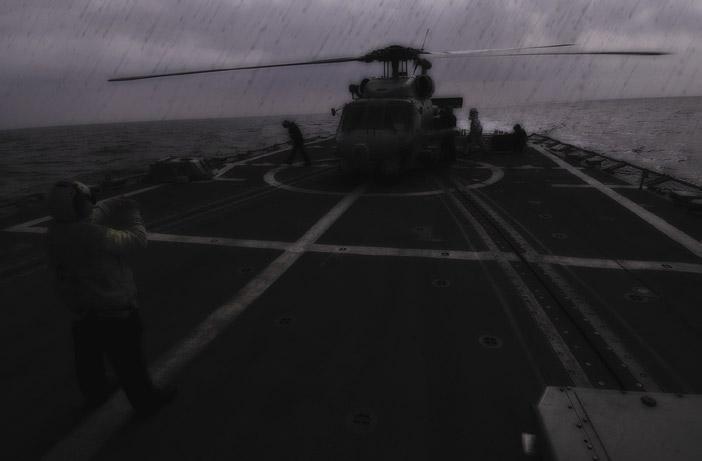

three feet above the flight deck. My copilot and I were completely unaware of the motion of the tip-path plane due to the darkness and rain; visual cues from the cockpit were a challenge. Also, the prevailing conditions did not allow the LSO to notice that the tip-path plane was lowering in front of the aircraft.
As near as I can tell, my placement of the cyclic must have caused the tip-path plane to descend. Concurrently, the tail strut must have lengthened—eventually to its fully extended position. Once this occurred, my copilot and I experienced abnormal vibrations in the cockpit. In retrospect, my suspicion is that the helicopter was pulling forward against the RSD on the flight deck, possibly causing the abnormal vibrations. Still unaware of the overall situation, we decided something was not right. Shutting down seemed like a good idea. As we disengaged rotors, we again experienced droop-stop pounding—only much more pronounced this time. My PC signaled to reengage rotors, which we did. At this point, we suspected a “hung droop stop” and started the NATOPS emergency procedure. However, adding to our confusion was the PC (actually, the PCUI because the PC had repositioned to get a view of the tail strut) was not signaling a hung-droop stop. We still were unaware at this point that the tip-path plane was low, and we didn’t know why we were experiencing the abnormal vibrations. In my frustration with the circumstances and thinking that my PCUI was not calling the hung-droop stops appropriately, we contacted the LSO and asked him to have maintenance send a more experienced PC to the flight deck. As if to add to our confusion, my copilot and I then witnessed a more experienced plane captain twice stick his head outside the hangar door, only to go back inside. We later learned the experienced PC was notifying the LSO about our tip-path plane. I will remember what happened next for a long time. I had begun to lose patience with

the ensuing confusion and directed my lead AD2 in the cabin of the aircraft to step out and call the hung-droop stops for us (to proceed with the shutdown). He stepped out of the aircraft and was trying to get permission from the PCUI to leave the rotor arc. All he got, though, was a very firm stop signal—thank God!
About that time, maintenance was able contact the LSO and inform him that the rotor-tip-path plane was extremely low. Upon receiving this information, we pulled our AD2 back into the cabin, reset the struts, and completed the shutdown without further incident.
We probably can glean many lessons from this story, but a review of events that evening led me to a few I’d like to share:
First, nothing on the flight deck is ever “routine,” especially when you’ve got a rotor head spinning at 258 rpm in the tight confines aboard an FFG. Events that can develop into a mishap never seem to follow a set script. Confusion is the mother of mishaps, and there certainly was enough confusion on the flight deck that night for a mishap to occur.
Second, my own impatience with the course of events only added to the confusion and tension level and could have resulted in a fatal mishap had enough safeguards not been in place. Our helicopter had experienced an inordinate number of problems over a twomonth span underway, resulting in less than 40 non-FCF hours being flown in 50 days at sea and two exercises. To give you an idea of the issues we’d been having with our helicopter, this was the 10th FCF we had done in that same time frame.
Third, thank God for an observant PCUI. If not for his assertiveness, I don’t want to think what the outcome could have been. The critical nature of observation during maintenance ground turns on a flight deck at night and in a driving rainstorm cannot be overstated. I’m thankful he had the presence of mind to stop the AD2 from exiting the rotor arc. And I’m also thankful my mech was well trained to pay close attention to directions from the PC/LSE before trying to exit the rotor arc.
We ended up changing out three of four droop stops before flying off pierside the next day. Considering what could have happened, I’d gladly pay the $1,250 bill.
Send BZs to: SAFE-Mech@navy.mil






AM3 Michael Monroe HM-15
Petty Officer Monroe noticed a broken section of the cowling screen on the tail gearbox while preflighting the tail-rotor driveshaft on Hurricane 07. Although the daily and turnaround inspection had revealed no discrepancies in that area, he notified his crew chief. Upon closer inspection, the crew chief found the screen had separated and peeled back from the airframe.
Petty Officer Monroe’s actions prevented a possible in-flight cowling failure that could have resulted in severe damage to the tail rotor and loss of the aircraft and crew.
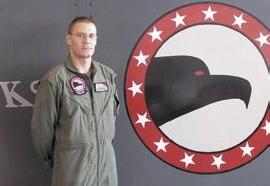
Sgt. Timothy O’Connor HMM-165
While conducting humanitarian missions in Indonesia during Operation Unified Assistance, Sgt. O’Connor (a CH-53E crew chief) discovered a worn pitch-control rod and bearing. He checked the integrity of the rod on a preflight inspection of the rotor-head assembly and noticed an unusual amount of play between the inner bearing and outer race. The Teflon that surrounds the bearing had worn down, allowing the bearing and the race to make metal-to-metal contact.
If Sgt. Connor had not discovered this condition, it would have caused the bearing to break loose and would have allowed the rod end to strike the sleeve and spindle, causing a total loss of control of the main rotor blade and supporting assembly.
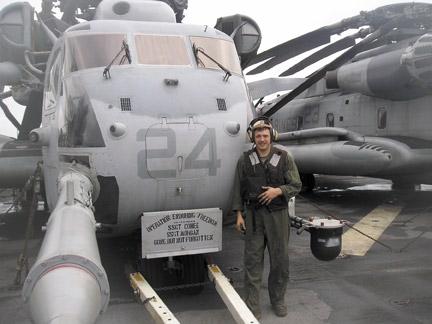
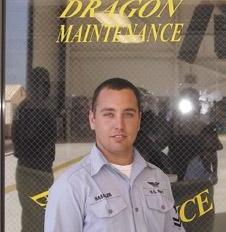
AM2(AW) Kenneth Hassler HS-11
During a daily and turnaround inspection, Petty Officer Hassler discovered a half-inch-by-7-inch delaminated section on the blue tail-rotor blade. He immediately downed the aircraft until critical repairs could be completed.
Petty Officer Hassler’s action prevented the tail rotor from departing the aircraft and resulting in loss of aircrew and aircraft.
AMAN Ricardo Amezcua CPRW-5
While helping to move an aircraft at night and in the rain, AMAN Amezcua heard a scraping noise coming from the port main mount on a P-3C. He halted the move and called for an immediate inspection of the main mount. That inspection revealed the wheel assembly was canted slightly and was broken.
Had the move continued, the wheel could have departed the aircraft, causing major damage to the aircraft and possible injury to ground personnel.
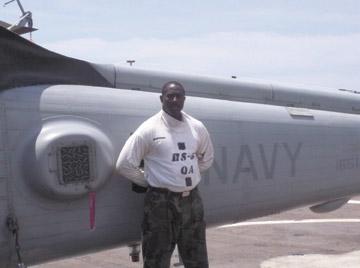
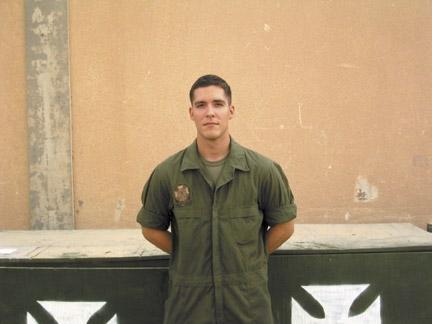
AM1 Flennoy Bellinger HS-5
While preparing to launch aircraft 615 as part of a two-helicopter launch, Petty Officer Bellinger glanced at aircraft 617 departing off the starboard beam of the ship. He noticed that the tail driveshaft cowling didn’t look right. He immediately went to the tower and requested radio contact with 617. He told the pilots to have the aircrew visually check the cowling to make sure it was secured.
The aircrew checked and confirmed that it wasn’t secure. Petty Officer Bellinger then safely and expeditiously shut down aircraft 615 and directed that it be moved into the hangar to make a ready deck to recover 617.
Petty Officer Bellinger quickly made the necessary repairs and got the aircraft airborne in just 15 minutes.

Cpl Adam Gomez HMLA-169
During a daily and turnaround inspection while deployed to Iraq, Cpl. Gomez found severe scoring of the No. 2 tail-rotor driveshaft in multiple locations of an AH1W. A broken Dzus fastener receptacle had fallen off the driveshaft access panel and lodged against the driveshaft. The driveshaft was removed for further inspection, and a crack was found from excessive scoring.
Cpl Gomez’s thorough inspection potentially saved the aircrew and aircraft from a catastrophic tail-rotor failure.
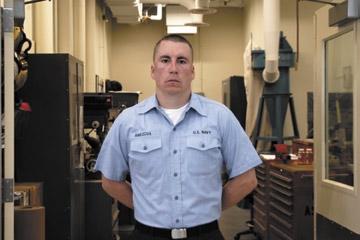
AMS3 Robert Tiller HS-5
Petty Officer Robert Tiller noticed something a little peculiar while working on a turn-around inspection of a squadron SH-60 helicopter. Upon closer inspection, he discovered and immediately reported a small tear on one of the plastic-coated, power available spindle (PAS) cables on an SH-60 helicopter. Had it not been for his keen attention to detail and quick response, the helo and its crew could have been in grave danger.
Mark Oakes NAVAIR Pax River
On an MH-60R’s 30-hour inspection, Mark Oakes discovered evidence of a crack that warranted further investigation.
The area was stripped, and the NDI lab inspected it, confirming a 1.8-inch crack at station 327 and just forward of the main beam, preventing the potential loss of aircraft and crew.
AMEAR Bryan Cunningham VAQ-135
While on a weekend security watch and during a walk-through of the hangar, AMEAR Cunningham noticed the whistling sound of a leaking liquid oxygen tank in aircraft 500. Upon further investigation, he found two of the aircraft’s three liquid oxygen tanks nearly encased in ice.
After consulting with a senior CDI/QAR for advice, he removed the tanks from the aircraft and drained them, a task made arduous by the dangerous and volatile nature of liquid oxygen.
Had this situation gone unnoticed, the
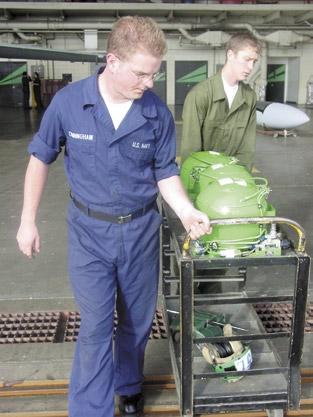
liquid oxygen tank could have exploded.
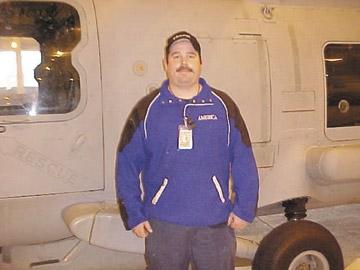
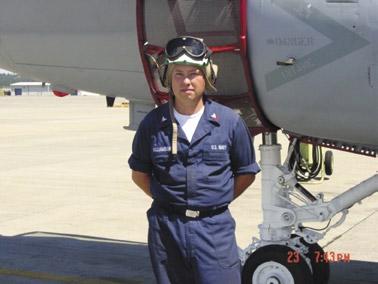
AD1 Mike Williamson VAQ-142
While troubleshooting compressor stalls on the port engine of aircraft 522, Petty Officer Williamson went the extra mile to determine the cause. Despite a thorough external inspection and ground maintenance turn that wasn’t able to duplicate the problem, he decided to do a borescope inspection of the engine and found foreign object damage in the sixth stage.
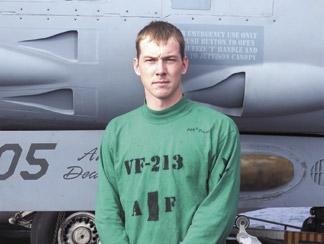
AM3 Craig Powers VF-213
While doing flight-deck familiarization training from vulture’s row onboard USS Theodore Roosevelt (CVN-71), Petty Officer Powers noticed a problem while pointing out hazardous areas in and around the landing area. He saw that the cable-support spring for the No. 3 arresting gear had broken after an E-2C Hawkeye did a touch and go landing.
Realizing that the flight-deck crew had not noticed the problem, Petty Officer Powers sprung into action and alerted a member of the crash crew. Flight-deck and primary control were notified in time to wave-off the air wing commander flying Blacklion 205, averting a possible mishap.
AM3 James Bales VAW-115
While doing a turn-around inspection on aircraft 603, Petty Officer Bales noticed a torque stripe was broken on one of the starboard wing-fold connecting points. He meticulously inspected the wing’s hinge and discovered catastrophic failure on the upper section.
Petty Officer Bales promptly reported his finding to the flight-deck coordinator and also notified maintenance control, averting a potentially catastrophic condition. The repair required the removal and replacement of the entire starboard wing.
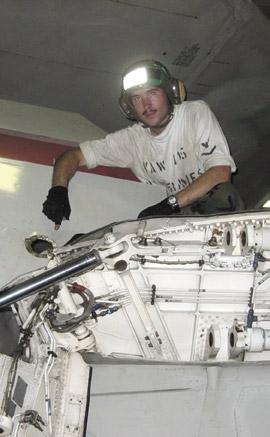
AMAN Amy Harmon VFA-204
On a daily inspection of River 403, Airman Harmon noticed a very faint defect in the trunnion on the starboard main landing gear. During a closer inspection of the trunnion, she determined the problem likely was a crack. She immediately notified maintenance control that the aircraft was down.
After removing the item for NDI inspection, maintainers found a nine-inch crack in the trunnion. Because of the obscure location of the defect, Airman Harmon found this defect only because of her thorough inspection and extreme attention to detail. This find prevented the catastrophic failure of the landing gear.
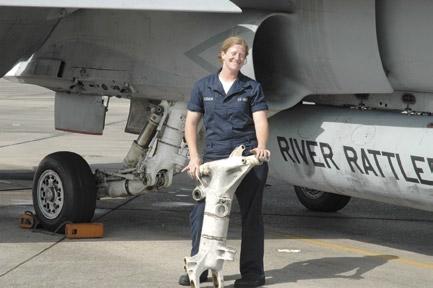
ADCS Gene Casterlin VF-31
Flight-deck crews reported a grinding noise coming from Felix 100 after it landed on USS Theodore Roosevelt (CVN-71). The aircrew hadn’t noticed any engine abnormalities throughout the flight, but they did feel a slight aircraft vibration just before landing. The aircraft was downed for further inspection. External inspection of the aircraft and motor casings, inlet and exhaust sections revealed no discrepancies. Senior Chief Casterlin, the QAS, directed a thorough borescope inspection of both engines’ combustion chambers and turbine sections. The inspection revealed that 83 percent of the port engine’s high-pressure-turbine blades were cracked and beginning to deteriorate. Senior Chief Casterlin’s persistence found the root cause of a potentially deadly discrepancy.
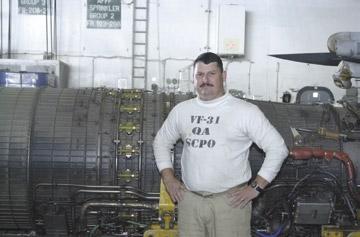
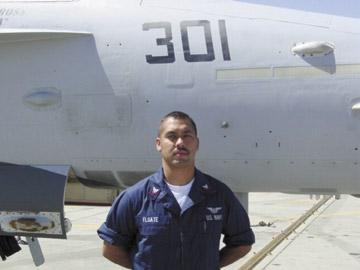
AME2 (AW) Michael Floate VFA-151
Petty Officer Floate was supervising the installation of FA-18 ejection system components in aircraft 301 when he discovered the aft-support bracket for the canopy rocket motor had been manufactured incorrectly.
Had this bracket been installed it may have resulted in serious injury to aircrew, or even loss of life, if a pilot had to eject. Petty Officer Floates’ initiative, attention to detail, and in-depth knowledge of the F/A-18 systems prevented this situation from happening.










